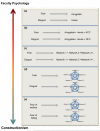A functional architecture of the human brain: emerging insights from the science of emotion
- PMID: 23036719
- PMCID: PMC3482298
- DOI: 10.1016/j.tics.2012.09.005
A functional architecture of the human brain: emerging insights from the science of emotion
Abstract
The 'faculty psychology' approach to the mind, which attempts to explain mental function in terms of categories that reflect modular 'faculties', such as emotions, cognitions, and perceptions, has dominated research into the mind and its physical correlates. In this paper, we argue that brain organization does not respect the commonsense categories belonging to the faculty psychology approach. We review recent research from the science of emotion demonstrating that the human brain contains broadly distributed functional networks that can each be re-described as basic psychological operations that interact to produce a range of mental states, including, but not limited to, anger, sadness, fear, disgust, and so on. When compared to the faculty psychology approach, this 'constructionist' approach provides an alternative functional architecture to guide the design and interpretation of experiments in cognitive neuroscience.
Copyright © 2012 Elsevier Ltd. All rights reserved.
Figures


References
-
- James W. The principles of psychology. Holt; 1890.
-
- Wundt W. Outlines of psychology. Thoemmes Press; 1897/1998.
-
- Ekman P, Cordaro D. What is meant by calling emotions basic. Emotion Review. 2011;3:364–370.
-
- Panksepp J. Affective neuroscience: The foundations of human and animal emotions. Oxford University Press; USA: 2004.
Publication types
MeSH terms
Grants and funding
LinkOut - more resources
Full Text Sources
Other Literature Sources

